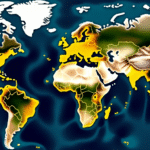Mexico’s Exposure to U.S. Trade Policy Changes
According to economists from the Institute of International Finance (IIF), Mexico is the most exposed Latin American economy to changes in U.S. trade policy. However, it is receiving preferential treatment alongside Canada in the application of reciprocal tariffs.
Regional Impact
Despite the negative impact on Latin American and Caribbean economic growth, the reciprocal tariffs from the U.S. place the region in a favorable position due to small bilateral trade imbalances, providing significant negotiation room and reduced exposure to U.S. trade.
Mexico’s Specific Exposure
Led by Chief Economist for Latin America, Martín Castellano, the negotiation between Mexico and the U.S. aims to strengthen the application of origin rules within the USMCA framework, reducing non-compliant exports, particularly in automobiles where a 25% tariff only applies to non-U.S. content value.
The Base Case recently reported that 63.13% of U.S. imports from Mexico fall outside the USMCA, as partners can choose to export using USMCA criteria or the most-favored-nation principle. However, 32% of Mexican exports to the U.S. are subject to a 25% tariff, impacting the economy equivalent to 6% of Mexico’s GDP.
Mexico’s Response
Mexican authorities, as outlined by the IIF analysis, have focused on concrete measures to address U.S. concerns about illegal immigration and drug trafficking, rather than prioritizing filing a complaint under the USMCA against arbitrary tariff imposition.
Ajay Banga, President of the World Bank, explained that this preferential treatment does not guarantee long-term stability and also creates uncertainty for investors.
IIF Overview
The IIF, with nearly 450 global financial institution members including global investment funds, issued the analysis during the parallel Global Economic Forum alongside FMI Spring Meetings and the World Bank.
Key Questions and Answers
- What is the IIF’s stance on Mexico’s position regarding U.S. tariffs? The IIF economists state that Mexico is the most exposed Latin American economy to U.S. trade policy changes, but it’s receiving preferential treatment alongside Canada in reciprocal tariff application.
- How do Mexico’s trade figures with the U.S. reflect tariff impacts? 63.13% of U.S. imports from Mexico fall outside the USMCA, while 32% of Mexican exports to the U.S. are subject to a 25% tariff, impacting the economy equivalent to 6% of Mexico’s GDP.
- What are Mexican authorities’ primary focus areas in response to U.S. concerns? Mexican authorities have prioritized concrete measures addressing illegal immigration and drug trafficking concerns, rather than filing a complaint under the USMCA against arbitrary tariff imposition.
- What is the IIF’s perspective on long-term stability due to preferential tariff treatment? According to Ajay Banga, President of the World Bank and part of the IIF, preferential tariff treatment does not guarantee long-term stability and creates uncertainty for investors.






